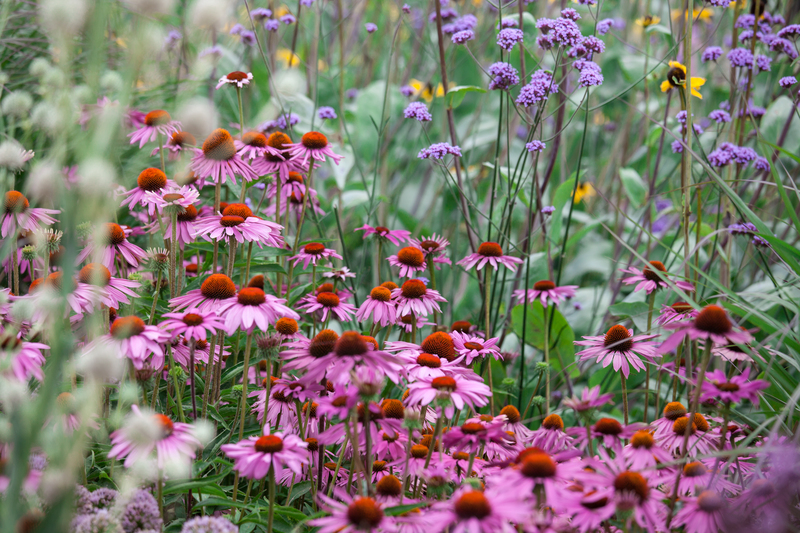The Complete Approach to Herb Garden Prosperity
Posted on 28/05/2025
The Complete Approach to Herb Garden Prosperity
If you dream of a flourishing herb garden in your backyard, balcony, or even windowsill, you're in the right place. Cultivating an herb garden is not just about planting seeds and watering them; it's about understanding the needs of your chosen plants and creating a space where they can thrive. In this comprehensive guide, you'll discover everything you need to know for successful & prosperous herb gardening--whether you're a beginner or a seasoned horticulturist.

Why Grow Your Own Herbs?
Herb gardens offer a plethora of benefits. Beyond the fresh flavors they bring to your kitchen, they are a source of beauty, fragrance, health, and even relaxation. Here's why starting your own herb garden pays off:
- Fresh Flavors: Homegrown herbs have stronger flavors than store-bought varieties.
- Cost Effective: Growing your own reduces grocery bills on fresh and dried herbs.
- Healthier Cooking: Fresh herbs encourage healthier meals loaded with nutrients and antioxidants.
- Aesthetic Beauty: Herb gardens are visually appealing and can be designed to compliment your landscape.
- Pest Control: Certain herbs deter pests naturally, leading to a more organic garden.
Herb garden prosperity means a thriving plot that supplies you with an abundance of aromatic, flavorful, and medicinal herbs all season long. Let's explore the complete approach to achieving this goal.
Planning Your Herb Garden for Success
Location and Sunlight
Most herbs love the sun. For best results and abundant growth, herbs need at least 6-8 hours of direct sunlight daily. When choosing a location:
- Opt for a south-facing spot for maximum light exposure.
- Ensure good drainage to avoid waterlogged roots.
- Consider easy access to the kitchen if cooking is a priority.
Container vs. In-ground Herb Gardening
Herbs are flexible and can be cultivated:
- In the ground: Great for larger spaces with healthy soil.
- In containers: Perfect for patios, balconies, and even indoors.
Choose containers with adequate drainage holes and use a high-quality potting mix.
Choosing a Herb Garden Layout
There is no one-size-fits-all when it comes to a prosperous herb garden layout, but consider these tips:
- Group by Watering Needs: Plant herbs with similar moisture preferences together, such as Mediterranean herbs (rosemary, thyme, sage) in one section, and water-loving herbs (mint, basil, cilantro) in another.
- Leave Room to Grow: Space plants adequately to avoid overcrowding, which leads to poor air circulation and disease.
- Accessibility: Install pathways for convenient harvesting and maintenance.
Selecting the Best Herbs for Prosperity
Easy-to-Grow Essentials
Start with time-proven herbs that thrive in most gardens:
- Basil: The king of summer herbs, essential for pesto and salads.
- Parsley: Versatile and packed with vitamins.
- Mint: Perfect for teas, desserts, and cocktails, but keep in containers to limit spreading.
- Rosemary: A hardy perennial with fragrant, needle-like leaves.
- Thyme: Small-leafed and aromatic, great for stews and meats.
- Cilantro: Adds freshness to salsas and curries.
Unique and Exotic Herbs
To enhance your garden's prosperity, consider adding specialty herbs:
- Lemongrass: Aromatic stalks for Asian-inspired dishes.
- Chives: Onion flavor for salads and baked potatoes.
- Dill: A must for pickling and seafood dishes.
- Tarragon: Delicate anise flavor, essential in French cuisine.
- Lavender: For fragrance, teas, and culinary bouquets.
Soil Preparation: The Foundation of Herb Garden Prosperity
Understanding Soil Requirements
The key to herb garden prosperity is fertile, well-drained soil. Herbs dislike standing water and soggy roots. Enrich the soil with these steps:
- Mix in organic matter like aged compost or well-rotted manure.
- Check pH: Most herbs prefer slightly alkaline to neutral soil (pH 6.5-7.5).
- For clay soils, improve drainage with sand or grit.
Mulching Matters
Mulch keeps roots cool, blocks weeds, and conserves water. Use organic mulches like straw or shredded leaves, but avoid piling against stems to prevent rot.
Planting Herbs for Maximum Prosperity
Seeds vs. Transplants
Seeds: Cost-effective and ideal for fast-growing annual herbs such as basil, cilantro, and dill. Start indoors for an early jump on the season.
Transplants: Perfect for slow-growing or perennials like rosemary, sage, or thyme. They give you a head start and can be purchased from local nurseries or online.
Steps for Planting Herbs
- Prepare the bed or container by loosening soil and incorporating compost.
- Sow seeds or transplant at the recommended depth and spacing (usually on the seed packet or plant tag).
- Water gently and keep soil moist until seedlings establish.
- Label each herb for easy identification.
Succession Planting for Year-Round Harvest
To ensure continuous harvests from your herb garden, practice succession planting. Stagger seed sowing every 2-3 weeks for herbs like cilantro, basil, and dill. This prevents gaps in production and ensures fresh leaves all season.
Watering and Feeding for Thriving Herbs
Proper Watering Techniques
Most herbs prefer soil that is moist but not waterlogged. Over-watering leads to root rot and fungal diseases, while under-watering causes stress and stunted growth. For abundant herb garden results:
- Water deeply and infrequently instead of shallow, daily watering.
- Water early in the morning to reduce evaporation and prevent fungal problems.
- Feel the soil before watering - if the top inch is dry, it's time to water.
Fertilization Strategies
Herbs generally require less fertilizer than vegetables. Over-fertilizing can lead to excessive leaf growth with less aromatic oils. For the best results:
- Apply a light dose of balanced, organic fertilizer (5-10-5 or 10-10-10) in early spring.
- Supplement with liquid seaweed or fish emulsion during the growing season.
- Compost tea keeps plants healthy and boosts microbial activity in the soil.
Maintaining Your Herb Garden for Maximum Prosperity
Pruning and Harvesting
Regular clipping not only supplies your kitchen but keeps herbs bushy and encourages new growth. For herb garden prosperity:
- Begin harvesting when plants are established and at least 6 inches tall.
- Use clean, sharp scissors to avoid damaging stems.
- Harvest in the morning when essential oil content is highest.
- Never remove more than one-third of the plant at a time.
Pest and Disease Control
Herbs are rarely troubled by pests due to their aromatic oils, but vigilance ensures a healthy garden. For natural herb garden protection:
- Inspect regularly for aphids, spider mites, and whiteflies.
- Use insecticidal soap or neem oil as organic controls.
- Remove diseased leaves and avoid overhead watering to reduce fungal issues.
- Encourage beneficial insects like ladybugs and lacewings.
Rotating Crops and Companion Planting
Rotate annual herb plantings each year to reduce soil-borne diseases. Companion planting also boosts herb garden success--basil with tomatoes, dill with cabbage, and mint near carrots are top combinations.
Preserving and Storing Your Herb Harvest
Drying Herbs
For winter use, preserve the bounty by drying. Hang small bunches upside down in a warm, dry, well-ventilated area away from sunlight. When completely dry, strip leaves, store in airtight containers, and label clearly.
Freezing and Infusing
- Freeze chopped herbs in ice cube trays with water or olive oil for use in soups and stews.
- Create infused oils or vinegars for vinaigrettes and marinades.
Proper storage maintains flavor, aroma, and color--an important step in achieving true herb garden prosperity throughout the year.
Common Mistakes and Solutions
- Overwatering: Monitor soil moisture and use well-draining containers or beds.
- Ignoring Pruning: Regular pinching and harvesting prevent woody, leggy plants.
- Planting in Poor Soil: Build your soil quality with organic amendments.
- Mixing Incompatible Herbs: Group herbs by their light and water needs.
- Not Rotating Crops: Move annuals to fresh soil each year to avoid disease buildup.
Design Ideas for a Beautiful and Productive Herb Garden
Formal Herb Gardens
Classic knot gardens use geometric layouts with low boxwood hedges, creating a visually appealing and orderly display.
Container Herb Gardens
For tight spaces, use a mix of terracotta pots, wooden boxes, and vertical wall planters. Herbs like basil, parsley, and chives do well in containers -- and can be moved for optimal light.
Companion Planting Beds
Mix herbs with vegetables and flowers for a holistic ecosystem. Calendula, marigold, and nasturtium add color and attract pollinators.

Herb Garden Prosperity: FAQs
- How often should I water my herbs? -- Water when the top inch of soil dries out, adjusting for location and weather.
- Which herbs thrive indoors? -- Basil, chives, mint, parsley, and thyme adapt well to indoor growing.
- How do I control pests naturally? -- Use neem oil, insecticidal soap, and encourage beneficial insects.
- How do I keep my herb garden productive all year? -- Use succession planting, preserve surplus harvest, and bring tender herbs indoors for winter.
Conclusion: Achieve Prosperity in Your Herb Garden
The complete approach to herb garden prosperity involves careful planning, thoughtful planting, consistent maintenance, and creative preservation. By understanding your plants' needs, improving your soil, using organic practices, and harvesting regularly, you'll enjoy a thriving, sustainable, and beautiful herb garden season after season. Whether gardening in pots, raised beds, or directly in the ground, these methods will lead to an abundant harvest that enriches your kitchen and your life. Start small, keep learning, and soon you'll be reaping the rewards of your flourishing herbal haven.

